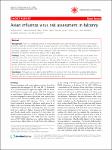Avian influenza virus risk assessment in falconry
Kohls, Andrea
Hafez, Hafez Mohamed
Harder, Timm
Jansen, Andreas
Lierz, Peter
Lüschow, Dörte
Schweiger, Brunhilde
Lierz, Michael
Background: There is a continuing threat of human infections with avian influenza viruses (AIV). In this regard falconers might be a potential risk group because they have close contact to their hunting birds (raptors such as falcons and hawks) as well as their avian prey such as gulls and ducks. Both (hunting birds and prey birds) seem to be highly susceptible to some AIV strains, especially H5N1. We therefore conducted a field study to investigate AIV infections in falconers, their falconry birds as well as prey birds. Findings: During 2 hunting seasons (2006/2007 and 2007/2008) falconers took tracheal and cloacal swabs from 1080 prey birds that were captured by their falconry birds (n = 54) in Germany. AIV-RNA of subtypes H6, H9, or H13 was detected in swabs of 4.1% of gulls (n = 74) and 3.8% of ducks (n = 53) using RT-PCR. The remaining 953 sampled prey birds and all falconry birds were negative. Blood samples of the falconry birds tested negative for AIV specific antibodies. Serum samples from all 43 falconers reacted positive in influenza A virus-specific ELISA, but remained negative using microneutralisation test against subtypes H5 and H7 and haemagglutination inhibition test against subtypes H6, H9 and H13. Conclusion: Although we were able to detect AIV-RNA in samples from prey birds, the corresponding falconry birds and falconers did not become infected. Currently falconers do not seem to carry a high risk for getting infected with AIV through handling their falconry birds and their prey.
Dateien zu dieser Publikation
Keine Lizenzangabe
Verwandte Publikationen
Anzeige der Publikationen mit ähnlichem Titel, Autor, Urheber und Thema.
-
2016-02-18ZeitschriftenartikelVaccine effectiveness in preventing laboratory-confirmed influenza in primary care patients in a season of co-circulation of influenza A(H1N1)pdm09, B and drifted A(H3N2), I-MOVE Multicentre Case–Control Study, Europe 2014/15 Valenciano, Marta; Kissling, Esther; Reuss, Annicka; Rizzo, C.; Gherasim, A.; Horváth, Judit K.; Domegan, L.; Pitigoi, Daniela; Machado, Ausenda; Bella, A.; Paradowska-Stankiewicz, I.; Larrauri, A.; Ferenczi, A.; O´Donell, Joan; Lazar, M.; Pechirra, P.; Korczyńska, M. R.; Pozo, Francisco; Moren, A.Influenza A(H3N2), A(H1N1)pdm09 and B viruses co-circulated in Europe in 2014/15. We undertook a multicentre case–control study in eight European countries to measure 2014/15 influenza vaccine effectiveness (VE) against ...
-
2016-10-13ZeitschriftenartikelImproving influenza virological surveillance in Europe: strain-based reporting of antigenic and genetic characterisation data, 11 European countries, influenza season 2013/14 Broberg, E.; Hungnes, Olav; Schweiger, Brunhilde; Prosenc, Katarina; Daniels, R.; Guiomar, R.; Ikonen, N.; Kossyvakis, A.; Pozo, Francisco; Puzelli, S.; Thomas, I.; Waters, A.; Wiman, Å.; Meijer, AdamInfluenza antigenic and genetic characterisation data are crucial for influenza vaccine composition decision making. Previously, aggregate data were reported to the European Centre for Disease Prevention and Control by ...
-
2013-02-14ZeitschriftenartikelEarly estimates of seasonal influenza vaccine effectiveness in Europe: results from the i-move multicentre case–control study, 2012/13 Valenciano, M.; Kissling, E.We conducted a test-negative case–control study based in five European sentinel surveillance networks. The early 2012/13 adjusted influenza vaccine effectiveness was 78.2% (95% CI: 18.0 to 94.2) against influenza B, 62.1% ...

